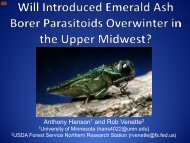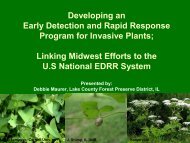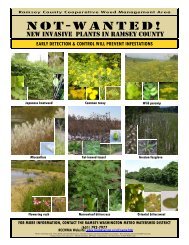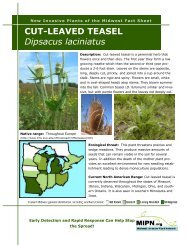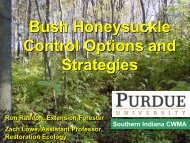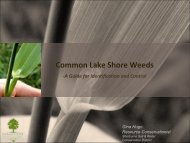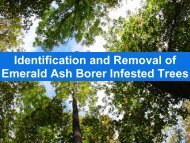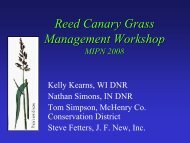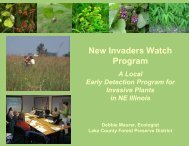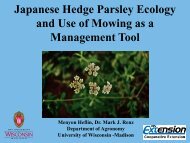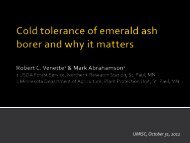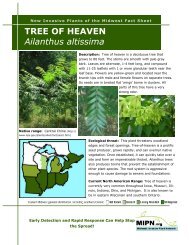Title, arial 30pt Bold, all caps - Midwest Invasive Plant Network
Title, arial 30pt Bold, all caps - Midwest Invasive Plant Network
Title, arial 30pt Bold, all caps - Midwest Invasive Plant Network
You also want an ePaper? Increase the reach of your titles
YUMPU automatically turns print PDFs into web optimized ePapers that Google loves.
PLANT COMMUNITY RESPONSE WHEN<br />
CONTROLLING INVASIVE WEEDS WITH<br />
AMINOPYRALID IN PRAIRIE RESTORATIONS<br />
Mary B. Halstvedt, Dow AgroSciences; Billings, MT<br />
Roger Becker, University of Minnesota; St Paul, MN<br />
Rodney Lym, North Dakota State University; Fargo, ND
Mary B. Halstvedt, Field Research Scientist<br />
Billings, MT<br />
mbhalstvedt@dow.com
Presentation Objectives<br />
‣ Role of aminopyralid in prairie restoration programs<br />
‣ Review plant community data from 2 research locations to<br />
illustrate response to herbicide application to shift<br />
communities away from invading plant species<br />
North Dakota State University study – 4 year old restoration<br />
University of Minnesota study – 2 year old restoration<br />
‣ Using current information to develop a treatment plan in<br />
prairie restorations
Ecologic<strong>all</strong>y Based Weed Management<br />
‣ Recognize plant communities are dynamic<br />
‣ Direct weed infested communities on trajectory to more<br />
desirable community that fits management goals<br />
(resistant to invasion, resilient after disturbance)<br />
‣ Utilize management tools in appropriate sequence and<br />
combination to expedite development of desired plant<br />
community<br />
Herbicides can be a catalyst for rapidly changing plant<br />
community composition<br />
|
Prairie Restorations or Reconstruction<br />
High priority across the Northern Plains and Upper <strong>Midwest</strong>
Canada thistle and other invasive weeds<br />
can be an issue at various stages of the<br />
restoration
Prairie restoration is complicated-requires<br />
significant vegetation management tools
Milestone ® (Aminopyralid) is Effective on Many<br />
<strong>Invasive</strong> Weeds<br />
Canada thistle<br />
Teasel<br />
Sweet clover<br />
Spotted knapweed<br />
Crown vetch<br />
Biennial thistles<br />
And many more – see label<br />
® Trademark of The Dow Chemical Company ("Dow) or an affiliated company of Dow Always read and follow label directions
Milestone ® Herbicide (Aminopyralid) Attributes<br />
Important for invasive weed management programs in<br />
natural areas:<br />
Low use rate of 3 to 7 fluid oz/acre (0.06 to 0.1 lb ae/acre)<br />
Reviewed and registered under the Reduced Risk Pesticide<br />
Initiative of the U.S. EPA<br />
Very low toxicity (“practic<strong>all</strong>y non-toxic”) to birds, fish, mammals and<br />
aquatic invertebrates<br />
Surface water breakdown in 16 hours<br />
Can be applied to season<strong>all</strong>y dry wetlands<br />
Spray up to the water’s edge<br />
Grass selectivity<br />
A single active ingredient to improve selectivity<br />
® Trademark of The Dow Chemical Company ("Dow) or an affiliated company of Dow<br />
Milestone is not registered for sale or use in <strong>all</strong> states. Contact your state pesticide regulatory agency to<br />
determine if a product is registered for sale or use in your state. Always read and follow label directions.<br />
|
Studies have shown that Milestone ® can be used to<br />
control invasive species and restore plant communities<br />
Most native forb species were<br />
moderately tolerant to tolerant, or<br />
quickly recovered following treatment<br />
Excellent grass tolerance<br />
and forage increase with<br />
treatment<br />
® Trademark of The Dow Chemical Company ("Dow) or an affiliated company of Dow<br />
|
Techlinenews.com<br />
References will<br />
be made to this<br />
effort throughout<br />
the presentation
Presentation Outline<br />
‣ Review plant community data from 2 research locations to illustrate<br />
response to herbicide application to shift communities away from<br />
invading plant species<br />
North Dakota State University study – 4 year old restoration<br />
University of Minnesota Study – 2 year old restoration<br />
‣ Using current information to develop a treatment plan in prairie<br />
restorations
What is the prairie restoration goal?<br />
A successful restoration is a diverse plant<br />
community that will include different levels of<br />
canopy cover and structural diversity to serve a<br />
wider array of birds, pollinator insects and other<br />
wildlife (taken from JB Bright TechLine article)
North Dakota State University Research<br />
Almquist, T.L. and R. G. Lym. 2010. Effect of Milestone ® on Canada<br />
Thistle (Cirsium arvense L.) and the Native <strong>Plant</strong> Community in a<br />
Restored T<strong>all</strong>grass Prairie. <strong>Invasive</strong> <strong>Plant</strong> Sci. Manage. April-June 2010.
Effect of Milestone on Canada Thistle (Cirsium arvense L.) and the<br />
Native <strong>Plant</strong> Community in a Restored T<strong>all</strong>grass Prairie<br />
‣ The Nature Conservancy’s Glacial<br />
Ridge Preserve<br />
‣ 4 - year old restoration on sandy<br />
beach-ridges of Glacial Lake<br />
Agassiz<br />
‣ Seeded in drill-strips with a mixture<br />
of native grasses and forbs<br />
http://www.minnesota-map.org/minnesota-map.jpg
NDSU Study Design<br />
9 m<br />
‣Randomized complete block<br />
60 plots: Canada thistle-infested plots<br />
were paired with non-infested restored<br />
native sites.<br />
‣30 native<br />
‣30 Canada thistle-infested<br />
6 m<br />
4.5 m<br />
All plots sub-divided<br />
‣One sub-plot randomly chosen for<br />
treatment<br />
6 m<br />
Aminopyralid<br />
Check<br />
‣Milestone ® (aminopyralid) at 7 fl<br />
oz/ac applied September 2006<br />
® Trademark of The Dow Chemical Company ("Dow) or an affiliated company of Dow
Materials and Methods<br />
‣ <strong>Plant</strong> community composition: Foliar cover in three<br />
randomly place 1-m 2 frames.<br />
Bareground, litter, and individual plant species cover were<br />
estimated in mid-July prior to herbicide treatment (baseline) and 10<br />
and 22 MAT<br />
<strong>Plant</strong> species were separated into high and low seral floristic quality<br />
categories*. High seral species are from stable plant communities<br />
and low seral indicate low quality prairie.<br />
‣ Canada thistle control was determined by counting stem<br />
density in six 0.25 m 2 quadrats.<br />
*Defined by the Northern Great Plains Floristic Quality Assessment Panel (2001)
Native vs Canada thistle sites – No Herbicide Treatment<br />
% Foliar Cover by Category<br />
120<br />
100<br />
80<br />
60<br />
40<br />
20<br />
0<br />
What impact does Canada thistle have on the prairie?<br />
Native<br />
Baseline<br />
Canada<br />
thistle<br />
infested<br />
Data will be presented in this stack<br />
graph format in the categories listed<br />
below. BG=bareground, Low=low seral<br />
BG litter <strong>Invasive</strong> Low forb Low grass High forb high grass
% Foliar Cover by Category<br />
Native vs Canada thistle area – No Herbicide Treatment<br />
120<br />
100<br />
80<br />
60<br />
40<br />
20<br />
0<br />
The Canada thistle impacts the grass cover more than forb cover<br />
Native<br />
Baseline 10 MAT 22 MAT<br />
Canada<br />
thistle<br />
Native<br />
Canada<br />
thistle<br />
Native<br />
BG liter Canada thistle Low forb<br />
Low grass High forb High grass<br />
Canada<br />
thistle
Treated<br />
Non-treated
Canada Thistle Control<br />
Evaluation date<br />
Treatment<br />
Prior to<br />
treatment 10 MAT 22 MAT<br />
Stems/m 2<br />
Non-treated 17 16 12<br />
Milestone ® 7 fl<br />
oz/ac<br />
15 0.1 1.3<br />
LSD (0.05) NS 1.3 1.2<br />
® Trademark of The Dow Chemical Company ("Dow) or an affiliated company of Dow
Results from Canada thistle-infested prairie restoration<br />
% Foliar Cover by Category<br />
100<br />
90<br />
80<br />
70<br />
60<br />
50<br />
40<br />
30<br />
20<br />
10<br />
0<br />
Baseline 10 MAT 22 MAT<br />
Milestone Untreated Milestone Untreated Milestone Untreated<br />
BG litter Canada thistle Low Forb<br />
Low Grass High Forb High Grass<br />
Milestone ® was applied once at 7 fl oz/ac in the f<strong>all</strong><br />
® Trademark of The Dow Chemical Company ("Dow) or an affiliated company of Dow Always read and follow label directions
Low Seral Broadleaves<br />
Dominated by<br />
common ragweed,<br />
black medick,<br />
perennial sowthistle,<br />
and dandelion
What are the main<br />
high-seral forbs?<br />
Should expect<br />
impact on the forbs<br />
based on tolerance<br />
chart (44% of the<br />
forb cover are<br />
species that are<br />
susceptible)<br />
Canada thistle infested<br />
0 MAT<br />
Scientific namea Common name Treated Control<br />
High-seral forbs<br />
Ranking<br />
Aster laevis L. Smooth blue aster
What are the main native forbs (High seral)?<br />
16<br />
Baseline<br />
10 MAT 22 MAT<br />
% Foliar Cover by Species<br />
14<br />
12<br />
10<br />
8<br />
6<br />
4<br />
2<br />
0<br />
Milestone Untreated Milestone Untreated Milestone Untreated<br />
White Aster Purple PC Max Sun CA gold<br />
Ppl Rue G Alex W Berg Other<br />
Milestone ® was applied once at 7 fl oz/ac in the f<strong>all</strong><br />
® Trademark of The Dow Chemical Company ("Dow) or an affiliated company of Dow Always read and follow label directions
Other Category: What new native forbs moved in that<br />
were not in pre-data?<br />
% Foliar Cover by Species<br />
1.6<br />
1.4<br />
1.2<br />
1<br />
0.8<br />
0.6<br />
0.4<br />
0.2<br />
0<br />
22 MAT<br />
Milestone<br />
Untreated<br />
Stiff Sunflower Fringed loosestrife Missouri goldenrod
Percent Foliar Cover of Canada Thistle and Grasses Before<br />
Treatment (Baseline) and 10 and 22 Months after Treatment with a<br />
f<strong>all</strong> application of Milestone ® at 7 fl oz/ac<br />
50<br />
Baseline 10 MAT 22 MAT<br />
% Canopy Cover<br />
40<br />
30<br />
20<br />
10<br />
0<br />
Untreated Milestone Untreated Milestone Untreated Milestone<br />
Canada thistle Big Bluestem Slender Wheatgrass Other Grasses<br />
® Trademark of The Dow Chemical Company ("Dow) or an affiliated company of Dow<br />
Always read and follow label directions
The benefits of Canada<br />
thistle control, removal of<br />
undesirable species, and<br />
increase in native grass cover<br />
should lead to an over<strong>all</strong><br />
improvement in long-term<br />
stability and composition of<br />
the prairie which likely will<br />
outweigh the short term<br />
impacts of herbicide<br />
treatment
University of Minnesota Study (Dr. Roger Becker): Milestone ®<br />
and Transline ® for Canada Thistle Control and Forb Tolerance<br />
Cooperator: JB Bright, USFWS Morris Wetland Management<br />
District, Morris, MN (Kufrin WPA Ortonville, MN)<br />
Research Question:<br />
Lots of thistle to start with!<br />
‣Will the use of herbicides early<br />
in the restoration program<br />
improve over<strong>all</strong> establishment of<br />
grasses and forbs?<br />
® Trademark of the Dow Chemical Company ("Dow) or an affiliated company of Dow
University of Minnesota: Materials and Methods<br />
‣ Randomized complete block design with 4 replications<br />
‣ Plot size: 20 by 30 feet<br />
‣ Herbicides applied with CO2 backpack – 20 GPA<br />
‣ Treatments: Milestone ® at 5 fl oz/ac, Transline ® at 2/3 pt/ac<br />
‣ Treatments in second year (2009) after seeding (2007)<br />
‣ Timing: June and September 2009<br />
® Trademark of the Dow Chemical Company ("Dow) or an affiliated company of Dow
Site Information<br />
‣ 6/20/2007: Spray with glyphosate and 2,4-D at 1 quart per acre of<br />
each<br />
‣ 6/21/2007: Broadcast seeded (vicon and culti-packer) into bean<br />
stubble with roughly 78% grass/22% forb mix, consisting of both<br />
purchased seed and remnant prairie harvest. At least 44 species<br />
seeded at a rate of approx. 38 seeds per square foot.<br />
‣ 6/25/2008: Mowed<br />
‣ 6/30/2009 and 8/12/2009 – mowed with exception of plots<br />
‣ 6/23/2010: Mowed
What forbs were seeded?<br />
23<br />
species<br />
Seeded<br />
OZ/Acre Seeds/Sq<br />
Common Name Latin Name % of Mix Seeded Ft (1 OZ)<br />
Common ox-eye Heliopsis helianthoides 1.34% 0.8 0.14<br />
Golden Alexander Zizia aurea 1.43% 0.4 0.3<br />
Harebell Campenula rotundifolia 3.93% 0.016 20.6<br />
Heart leaf golden Alexander Zizia aptera 0.31% 0.096 0.275<br />
Hoary vervain Verbena stricta 1.22% 0.16 0.64<br />
Large Flowered Beardstongue Penstomen grandiflorus 1.53% 0.4 0.32<br />
Leadplant Amorpha canescens 0.76% 0.16 0.4<br />
Maximillian sunflower Helianthus maximilliani 5.53% 1.6 0.29<br />
N. leaf purple coneflower Echinacea angustifolia 1.53% 0.8 0.16<br />
Prairie cinquefoil Potentilla arguta 6.07% 0.096 5.3<br />
Prairie coneflower Ratibida columnifera 9.27% 0.81 0.96<br />
Prairie coreopsis Coreopsis palmata 1.12% 0.41 0.23<br />
Prairie onion Allium stellatum 1.22% 0.41 0.25<br />
Purple prairie clover Dalea purpureum 11.35% 2.8 0.34<br />
Prairie Sage Artemisia ludoviciana 3.26% 0.048 5.7<br />
Rough blazing star Liatris aspera 1.07% 0.25 0.36<br />
Showy goldenrod Solidago speciosa 10.26% 0.41 2.1<br />
Showy tick trefoil Desmodium canadense 2.29% 1.6 0.12<br />
Smooth aster Aster laevis 2.72% 0.19 1.2<br />
Stiff goldenrod Solidago rigida-summer 9.18% 0.816 0.94<br />
Solidago rigida - f<strong>all</strong><br />
White prairie clover Dalea candidum 9.54% 2 0.4<br />
Wild bergamot Monarda fistulosa 7.63% 0.4 1.6<br />
Yarrow Achillea millefolium 7.44% 0.16 3.9
Herbicide Application Dates<br />
June 25, 2009:<br />
Canada thistle emerged and up<br />
to 30 inches, bud stage<br />
September 23, 2009:<br />
Canada thistle stage: New thistle shoots<br />
vegetative and 6 to10 inches - some old shoots<br />
that emerged last spring remain with 30-40 %<br />
green tissue
<strong>Plant</strong> Community Response Data:<br />
2010, 2011, and 2012<br />
‣Total cover by category: July and September<br />
Canada thistle, native forbs, exotic forbs, native grass,<br />
and bareground<br />
‣<strong>Plant</strong> density (forbs) by species per square yard
<strong>Plant</strong> Community - % Cover by Category – July 2010<br />
Evaluation - 1 YAT<br />
100<br />
% Cover by Category<br />
80<br />
60<br />
40<br />
20<br />
0<br />
Milestone<br />
Summer<br />
Milestone<br />
F<strong>all</strong><br />
Transline<br />
Summer<br />
Transline<br />
F<strong>all</strong><br />
Untreated<br />
Bare Grd Canada thistle Native Forbs Exotic Grasses<br />
No statistical differences within the cover category (P=0.1)
Forb Density by Species – 1 YAT<br />
Density per square Yard<br />
40<br />
35<br />
30<br />
25<br />
20<br />
15<br />
10<br />
5<br />
0<br />
*<br />
Note: Canada goldenrod (S. canadensis) was not a planted species<br />
*Statistical difference (P=0.1)<br />
Milestone<br />
Summer<br />
Milestone<br />
F<strong>all</strong><br />
Transline<br />
Summer<br />
Transline<br />
F<strong>all</strong><br />
Untreated<br />
CA gold Rigid gold PP Clover Gld Alex Wild Berg<br />
Yarrow White sage White aster Heath aster other<br />
Other includes smooth blue aster, long headed coneflower, oxeye sunflower,<br />
white prairie clover, Maximillian sunflower, and hoary vervain
<strong>Plant</strong> Community - % Cover by Category – September<br />
2010 Evaluation<br />
100<br />
% Cover by Category<br />
80<br />
60<br />
40<br />
20<br />
0<br />
Milestone<br />
summer<br />
Milestone<br />
F<strong>all</strong><br />
Transline<br />
summer<br />
Transline<br />
F<strong>all</strong><br />
Untreated<br />
Mow<br />
Bare Grd Canada thistle Native Forbs Exotic Grasses
“Results were very<br />
enlightening because<br />
native forbs were visu<strong>all</strong>y<br />
more robust in herbicide<br />
treated plots compared to<br />
mowed plots. The<br />
herbicide treatments<br />
greatly reduced<br />
competition from Canada<br />
thistle and opened a niche<br />
for native forb and seeded<br />
grasses to thrive”. (J.B.<br />
Bright, USFWS Kufrin WPA)
Kufrin WPA – 2 Years after treatment
<strong>Plant</strong> Community - % Cover by Category – July 2011<br />
Evaluation - 2 YAT<br />
% Cover by Category<br />
100<br />
80<br />
60<br />
40<br />
20<br />
0<br />
b<br />
ab<br />
Milestone<br />
Summer<br />
Milestone<br />
F<strong>all</strong><br />
b a ab ab ab<br />
b b b<br />
Transline<br />
Summer<br />
Transline<br />
F<strong>all</strong><br />
a<br />
Untreated<br />
c<br />
Mow<br />
CT Native Forb Sweet clover Native Grass Bare Grd<br />
Statistics across cover category (P=0.1)
Total Forb Density by Species – July 2011 (2 YAT)<br />
Density per square Yard<br />
40<br />
35<br />
30<br />
25<br />
20<br />
15<br />
10<br />
5<br />
0<br />
No statistical differences (P=0.1)<br />
Milestone<br />
Summer<br />
Milestone<br />
F<strong>all</strong><br />
Transline<br />
Summer<br />
Transline<br />
F<strong>all</strong><br />
Untreated<br />
CA goldrod Rigid goldrod PP Clover GlAlex<br />
Wild Berg yarrow White sage White aster<br />
Heath aster<br />
other<br />
Other includes long headed coneflower, oxeye sunflower, white prairie clover,<br />
Maxmillian sunflower, and hoary vervain<br />
Note: Canada goldenrod (S. canadensis) was not a planted species
2012 <strong>Plant</strong> Community Evaluation – 3 years after herbicide<br />
and mowing
<strong>Plant</strong> Community - % Cover by Category – July 2012<br />
Evaluation - 3 YAT<br />
100<br />
% Cover by Category<br />
80<br />
60<br />
40<br />
20<br />
0<br />
ab<br />
Milestone<br />
summer<br />
a a a a a a<br />
a<br />
Milestone<br />
F<strong>all</strong><br />
ab ab ab b<br />
Transline<br />
Summer<br />
Transline<br />
F<strong>all</strong><br />
Untreated<br />
Mow<br />
Canada thistle Native Forbs Exotic Native Grasses Bare Grd<br />
Statistics across cover category (P=0.1)
Total Forb Density by Species – July 2012 (3 YAT)<br />
Statistics –total density top letter – wild bergamot in green (P=0.1)<br />
a<br />
Density per square Yard<br />
100<br />
80<br />
60<br />
40<br />
20<br />
0<br />
ab<br />
bc<br />
Milestone<br />
summer<br />
ab<br />
ab<br />
Milestone<br />
F<strong>all</strong><br />
ab<br />
ab<br />
Transline<br />
Summer<br />
ab<br />
ab<br />
Transline<br />
F<strong>all</strong><br />
a<br />
Untreated<br />
c<br />
b<br />
Mow<br />
CA gold Rigid gold PP Clover Gld Alex Wild Berg<br />
yarrow White sage White aster Heath aster other<br />
Other includes long headed coneflower, giant goldenrod, oxeye<br />
sunflower, white prairie clover, Maximillian sunflower, and hoary vervain
Density per square Yard<br />
60<br />
40<br />
20<br />
0<br />
Total Forb Count by Species – July 2012 (3 YAT)<br />
a<br />
Milestone<br />
summer<br />
Without wild bergamot<br />
a<br />
Milestone<br />
F<strong>all</strong><br />
Transline<br />
Summer<br />
Transline<br />
F<strong>all</strong><br />
Untreated<br />
CA gold Rigid gold PP Clover Gld Alex yarrow<br />
White sage White aster Heath aster other<br />
a<br />
Mow<br />
Other includes long headed coneflower, giant goldenrod, oxeye sunflower, white prairie<br />
clover, Maximillian sunflower, and hoary vervain<br />
Statistics –total density (P=0.1)<br />
a<br />
a<br />
a
Forb density per sq yd<br />
100<br />
90<br />
80<br />
70<br />
60<br />
50<br />
40<br />
30<br />
20<br />
10<br />
0<br />
Best Treatment option if Canada thistle is the target<br />
Milestone<br />
2010<br />
Milestone<br />
2011<br />
Milestone<br />
2012<br />
Untreated<br />
2010<br />
Untreated<br />
2011<br />
Untreated<br />
2012<br />
Gold Alex Wild Bergamont CA Goldenrod<br />
Rigid Goldenrod Prple Prairie Clover White Sage<br />
Yarrow<br />
Grass<br />
Forb<br />
Milestone ® at 5 fl<br />
oz/ac in June of 2009<br />
Other<br />
More forb cover<br />
but dominated<br />
by one species<br />
No statistical differences comparing by year (P=0.1)<br />
® Trademark of the Dow Chemical Company ("Dow) or an affiliated company of Dow
Summary and Conclusions – Minnesota Study<br />
‣ <strong>Plant</strong> communities are dynamic! These data may be<br />
different if Canada thistle did not decline in untreated.<br />
‣ 3 years after herbicide treatments:<br />
Forb cover was equal across herbicide treatments and<br />
untreated and the mowing had the lowest forb cover.<br />
Native grass cover was statistic<strong>all</strong>y the same for <strong>all</strong> herbicide<br />
treatments, mowing, and untreated.<br />
Wild bergamot became very dominant on the site and highest<br />
in the untreated.<br />
Forb density was equal across <strong>all</strong> inputs. Forb diversity was<br />
equal across herbicide treatments but slightly higher in the<br />
summer treatments and closer to the untreated.
Milestone Herbicide ® (aminopyralid) is an important<br />
tool for invasive plants management in natural areas<br />
to restore plant communities or facilitate recovery of<br />
desirable grasses and forbs.<br />
Selective weed control gives<br />
desirable vegetation a<br />
competitive advantage.<br />
®<br />
Trademark of The Dow Chemical Company ("Dow) or an affiliated company of Dow
Integrated Weed Management in Prairie<br />
Restorations<br />
‣Site survey – mapping invasive weeds – the big<br />
picture<br />
|
Dense<br />
Scattered<br />
Broadcast<br />
treatments<br />
versus large<br />
patch spraying<br />
High Priority – near road
Integrated Weed Management in Prairie<br />
Restorations<br />
‣ Site survey – mapping invasive weeds – the big picture<br />
‣ Management history of site<br />
‣ Desired plant community characteristics<br />
‣ Develop plan for using management tools in the right sequence<br />
and combination to expedite establishment of desired plant<br />
community<br />
Herbicides can be a catalyst for rapidly changing plant<br />
community composition<br />
|
Developing a Herbicide Control Strategy<br />
‣ Focus on areas where invasive<br />
species are having the most<br />
impact on plant community<br />
‣ Utilize current information to<br />
understand the benefit and risk of<br />
treatment<br />
What are the main forbs and what<br />
is the tolerance to herbicide?<br />
What grasses are present to<br />
respond to removal of invasive<br />
weed?<br />
‣ Choose appropriate herbicide rate<br />
and application timing to create<br />
mosaic of greater forb diversity
In new restorations that are likely to be prone to Canada<br />
thistle invasion, consider planting forbs that are more<br />
tolerant to Milestone ® ®<br />
Trademark of The Dow Chemical Company ("Dow) or an affiliated company of Dow
Thank You to my co-authors and the technicians<br />
and students that conducted these research<br />
projects<br />
Dr. Roger Becker, University of Minnesota; St Paul, MN<br />
Dr. Rodney Lym, North Dakota State University; Fargo, ND<br />
® Trademark of The Dow Chemical Company (“Dow”) or an affiliated company of Dow





